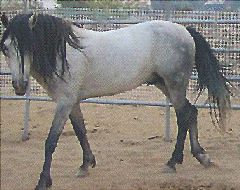![]() Known
for their high intelligence, the Mustang can be an extremely loyal companion,
able to compete and perform in many different equine disciplines.
Known
for their high intelligence, the Mustang can be an extremely loyal companion,
able to compete and perform in many different equine disciplines.

![]() The
modern Mustang herds originated from horses that were imported from Spain,
in the 16th century. Their very name, Mustang, is thought to originate
from a Spanish word, mesteno - from mesta, meaning an association
of graziers or stock raisers.
The
modern Mustang herds originated from horses that were imported from Spain,
in the 16th century. Their very name, Mustang, is thought to originate
from a Spanish word, mesteno - from mesta, meaning an association
of graziers or stock raisers.
![]() Brought to the western
United States to work on newly formed cattle ranches by the Spaniards,
a few Mustang's escaped and quickly reverted to their predomesticated
ways, living in the wild. Stallion dominated groups of mares were soon
roaming the western U.S., and by the beginning of the twentieth century,
approximately 1 million wild horses lived in the west. This number decreased
by 1970, due to commercialization of the land -- today, the wild Mustang
is protected by the 1971 act of protection.
Brought to the western
United States to work on newly formed cattle ranches by the Spaniards,
a few Mustang's escaped and quickly reverted to their predomesticated
ways, living in the wild. Stallion dominated groups of mares were soon
roaming the western U.S., and by the beginning of the twentieth century,
approximately 1 million wild horses lived in the west. This number decreased
by 1970, due to commercialization of the land -- today, the wild Mustang
is protected by the 1971 act of protection.
![]() Interesting
to note, initially, Indians were inclined to kill and eat any horses they
captured from the settlers. However, in time, they began to realize the
value of the horse as a means of transport. By the second half of the
seventeenth century, some tribes were taking horses from the Spaniards
and using them in mounted raids against the newcomers.
Interesting
to note, initially, Indians were inclined to kill and eat any horses they
captured from the settlers. However, in time, they began to realize the
value of the horse as a means of transport. By the second half of the
seventeenth century, some tribes were taking horses from the Spaniards
and using them in mounted raids against the newcomers.

![]() Mustangs
are very agile, intelligent, hardy and fast. They have exceptionally broad
and strong bodies; they have very hard and enduring legs. Because of the
tough wilderness life these horses lead -- foraging on whatever is available
in the wilderness to eat -- they have developed strong sturdy hooves which
never need shoeing.
Mustangs
are very agile, intelligent, hardy and fast. They have exceptionally broad
and strong bodies; they have very hard and enduring legs. Because of the
tough wilderness life these horses lead -- foraging on whatever is available
in the wilderness to eat -- they have developed strong sturdy hooves which
never need shoeing.
![]() Any
color is acceptable in the Mustang. Because of its mixed ancestry (the
original Spanish stock was progressively diluted as a wide variety of
settlers' horses escaped and joined the wild herds, and interbred with
the wild horses), there is a good deal of variation. The ideal Mustang
is one that is sturdily built with strong, clean limbs and feet.
Any
color is acceptable in the Mustang. Because of its mixed ancestry (the
original Spanish stock was progressively diluted as a wide variety of
settlers' horses escaped and joined the wild herds, and interbred with
the wild horses), there is a good deal of variation. The ideal Mustang
is one that is sturdily built with strong, clean limbs and feet.

![]() Information
on this breed came from "The Ultimate Book of the Horse and Rider," by
Judith Draper, Debby Sly and Sarah Muir; pages 138-139. Photo came from
Wild
Horses & Burros.
Information
on this breed came from "The Ultimate Book of the Horse and Rider," by
Judith Draper, Debby Sly and Sarah Muir; pages 138-139. Photo came from
Wild
Horses & Burros.
